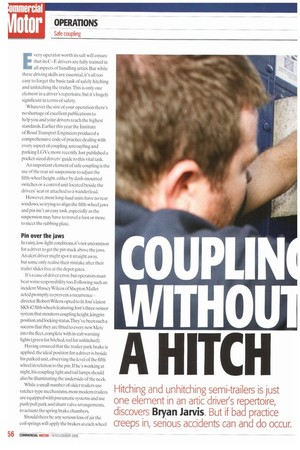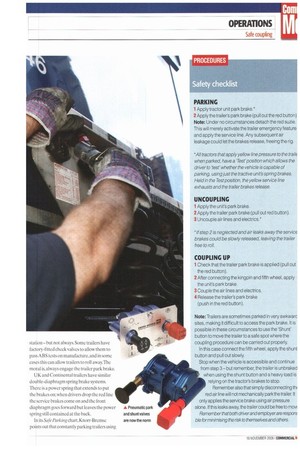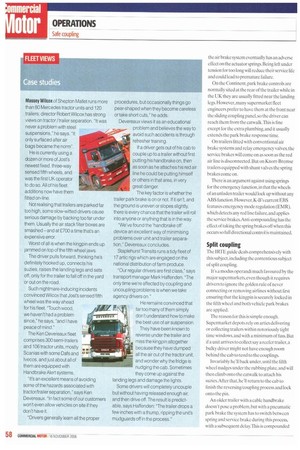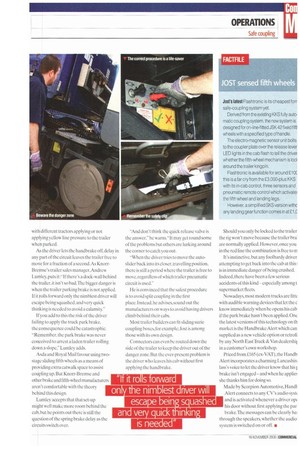E very operator worth its salt will ensure that its C+E
Page 56

Page 57

Page 58

Page 59

If you've noticed an error in this article please click here to report it so we can fix it.
drivers are fully trained in all aspects of handling artics. But while these driving skills are essential, it's all too easy to forget the basic task of safely hitching and unhitching the trailer.This is only one element in a driver's repertoire, but it's hugely significant in terms of safety.
Whatever the size of your operation there's no shortage of excellent publications to help you and your drivers reach the highest standards. Earlier this year the Institute of Roadli.ansport Engineers produced a comprehensive code of practice dealing with every aspect of coupling. uncoupling and parking LGVs: more recently Jost published a pocket-sized drivers' guide to this vital task.
An important element of safe coupling is the use of the rear air suspension to adjust the fifth-wheel height, either by dash-mounted switches or a control unit located beside the drivers' seat or attached to a wanderlead.
However, most long-haul units have no rear windows, so trying to align the fifth-wheel jaws and pin isn't an easy task, especially as the suspension may have to travel a foot or more to meet the rubbing plate.
Pin over the jaws
In rainy, low-light conditions,it's not uncommon for a driver to get the pin stuck above the jaws. An alert driver might spot it straight away, but some only realise their mistake after their trailer slides free at the depot gates.
It's a case of driver error, but operators must bear some responsibility too.Following such an incident Massey Wilcox of Shepton Mallet acted promptly to prevent a recurrence director Robert Wilcox opted to lit kist's latest SKS 42 fifth wheels featuringiost's three-sensor system that monitors coupling height. kingpin position and locking status.They've been such a success that they are fitted to every new Mere into the fleet.complete with in-cab warning lights (green for hitched, red for unhitched).
Having ensured that the trailer park brake is applied, the ideal position for a driver is beside his parked unit, observing the level of the fifth wheel in relation to the pin. If he's working at night. his coupling light and tail lamps should also be illuminating the underside of the neck.
While a small number of older trailers use ratchet-type mechanisms, most modem trailers are equipped with pneumatic systems and use push/pull park and shunt valve arrangements. to actuate the spring brake chambers.
Should there be any serious loss of air the coil springs will apply the brakes at each wheel station—but not always. Some trailers have factory-fitted check valves to allow them to pass ABS tests on manufacture, and in some cases this can allow trailers to roll away.The moral is. always engage the trailer park brake.
UK and Continental trailers have similar double-diaphragm spring brake systems. There is a power spring that extends to put the brakes on: when drivers drop the red line the service brakes come on and the front diaphragm goes forward but leaves the power spring still contained at the back.
In its Safe Parking chart,Knorr-Bremse points out that constantly parking trailers using the air brake system eventually has an adverse effect on the actuator springs. Being left under tension for too long will reduce their service life and could lead to premature failure.
On the Continent, park brake controls are normally sited at the rear of the trailer while in the UK they are usually fitted near the landing legs. However, many supermarket fleet engineers prefer to have them at the front near the sliding coupling panel, so the driver can reach them from the catwalk.This is fine except for the extra plumbing. and it usually extends the park brake response time.
On trailers fitted with conventional air brake systems and relay emergency valves, the service brakes will come on as soon as the red air line is disconnected. But on Knorr-Bremse trailers equipped with shunt valves the spring brakes come on.
There is an argument against using springs for the emergency function, in that the wheels of an unladen trailer would lock up without any ABS function.However,K-B's current EBS features emergency mode regulation (EMR), which detects any red line failure, and applies the service brakes.Anti-compounding has the effect of taking the spring brakes off when this occurs so full directional control is maintained.
Split coupling
The 1RTE guide deals comprehensively with this subject, including the contentious subject of split coupling.
Ifs a modus operandi much favoured by the major supermarkets,even though it requires drivers to ignore the golden rule of never connecting or removing airlines without first ensuring that the kingpin is securely locked in the fifth wheel and both vehicle park brakes are applied.
The reason for this is simple enough. Supermarket depots rely on artics delivering or collecting trailers within notoriously tight time windows, and with a minimum of fuss. But if a unit arrives to collect say a reefer trailer, a bulky driver might not have enough room behind the cab to tend to the couplings.
Invariably he'll back under, until the fifth wheel nudges under the rubbing plate, and will then climb onto the catwalk to attach his suzies.After that,he'll return to the cab to linish the reversing/coupling process and lock onto the pin.
An older trailer with a cable handbrake doesn't pose a problem, but with a pneumatic park brake the system has to switch between spring and service brake during this process, with a subsequent delay.'This is compounded with different tractors applying or not applying yellow line pressure to the trailer when parked.
As the driver lets the handbrake off, delay in any part of the circuit leaves the trailer free to move for a fraction of a second. As KnorrBrernse's trailer sales manager, Andrew Lumley, puts it:" If there's a dock-wall behind the trailer, it isn't so bad.The bigger danger is when the trailer parking brake is not applied. If it rolls forward only the nimblest driver will escape being squashed, and very quick thinking is needed to avoid a calamitv."
If you add to this the risk of the driver failing to apply the truck park brake. the consequence could be catastrophic. "Remember, the park brake was never conceived to arrest a laden trailer rolling down a slope," Lumley adds.
Asda and Royal Mail favour using twostage sliding fifth wheels as a means of providing extra catwalk space to assist coupling up. But Knorr-Bremse and other brake and fifth-wheel manufacturers aren't comfortable with the theory behind this design.
Lumley accepts that that set-up might well make more room behind the cab, but he points out there is still the question of the spring brake delay as the circuits switch over. "And don't think the quick release valve is the answer.he warns. "it may get round some of the problems but others are lurking around the corner to catch you out.
-When the driver tries to move the autoslider back into its closer, travelling position, there is still a period where the trailer is free to move, regardless of which trailer pneumatic circuit is used.
He is convinced that the safest procedure is to avoid split coupling in the first place. Instead, he advises, sound out the manufacturers on ways to avoid having drivers climb behind their cabs.
Most trailer builders can fit sliding suzie coupling boxesjor example-Jost is among those with its own design.
Connectors can even he routed down the side of the trailer to keep the driver out of the danger zone. But the ever-present problem is the driver who leaves his cab without first applying the handbrake. Should you only be locked to the trailer the rig won't move because the trailer bra] are normally applied. However, once you in the red line the combination is free turn It's inst inctive, but any foolhardy driver attempting to get back into the cab at this is in immediate danger of being crushed. Indeecl,therc have been a few serious accidents uf this kind —especially among supermarket fleets.
Nowadays, most modern trucks are fitt( with audible warning devices that let the e know immediately when he opens his cab if the park brake hasn't been applied. One the latest versions of this technology on th market is the Handbrake Alert which can supplied as a new vehicle option or retrofi by any North East Truck & Van dealershil in a customer's own workshop.
Priced from £165 (ex-VAT), the Handb Alert incorporates a charming Lancashin lass's voice to let the driver know that his I brake isn't engaged —and when he applies she thanks him for doing so.
Made by Scorpion Automotive, Han& Alert connects to any CV's audio systi and is activated whenever a driver op( his door without first applying the par. brake, The messages can be clearly he through the speakers, whether the audio system is switched on or off. •
























































































































































































